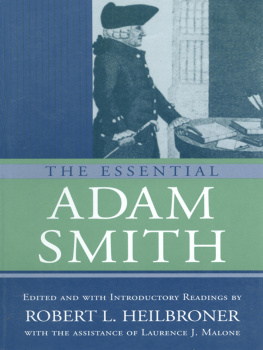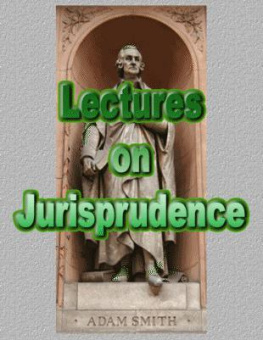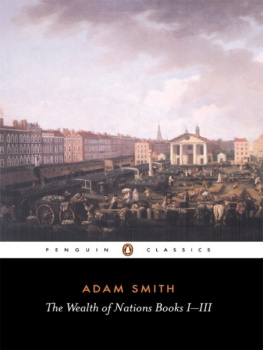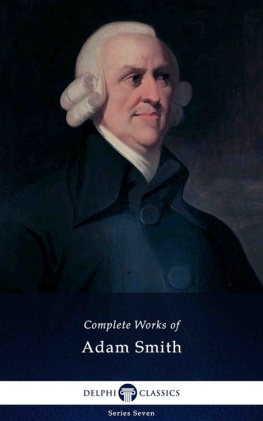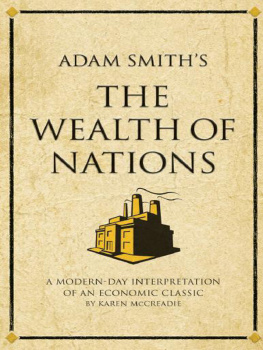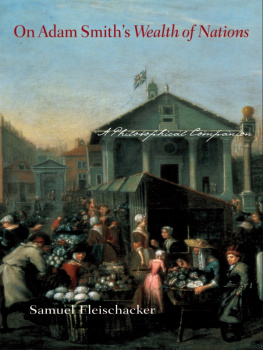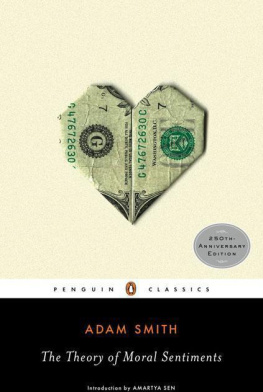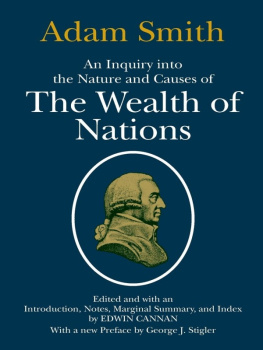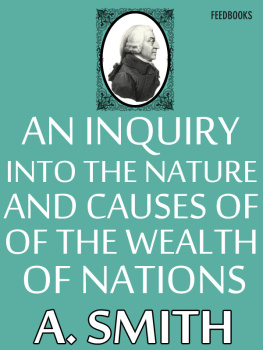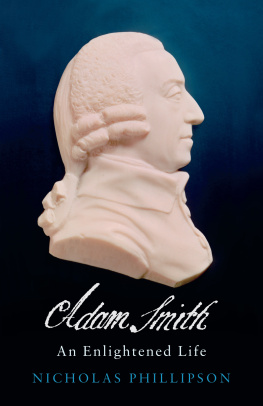
BOOKS BY
ROBERT L. HEILBRONER
The Nature and Logic of Capitalism
Marxism: For and Against
Beyond Boom and Crash
Business Civilization in Decline
An Inquiry into the Human Prospect
Between Capitalism and Socialism
The Economic Problem
The Limits of American Capitalism
A Primer on Government Spending
(with Peter L. Bernstein)
The Great Ascent
The Making of Economic Society
The Future as History
The Quest for Wealth
The Worldly Philosophers
The Essential Adam Smith
Edited and with
Introductory Readings by
Robert L. Heilbroner
with the Assistance of
Laurence J. Malone
W W NORTON & COMPANY New YorkLondon
Copyright 1986 by Robert L. Heilbroner
All rights reserved.
Printed in the United States of America.
The text of this book is composed in Electra, with display type set in Bernhard Modern. Composition and Manufacturing by the Maple-Vail Book Manufacturing group.
First published in Norton paperback 1987
Library of Congress Cataloging-in-Publication Data
Smith, Adam, 17231790.
The essential Adam Smith.
Includes index.
1. Smith, Adam, 17231790Addresses, essays, lectures. 2. Economics
Addresses, essays, lectures. I. Heilbroner, Robert L. II. Malone, Laurence J. III. Title.
HB103.S6A48 1986 330.153 8521394
ISBN 0-393-95530-3
ISBN 978-0-393-24260-7 (e-book)
W. W. Norton & Company, Inc., 500 Fifth Avenue, New York, N.Y. 10110
www.wwnorton.com
W. W. Norton & Company Ltd., Castle House, 75/76 Wells Street, London WIT 3QT
Contents
No economists name is more frequently invoked than that of Adam Smith, and no economists works are less frequently read. An aura surrounds Smith, endowing his name with an authority not enjoyed by any other worldly philosopher except Marx. Needless to say, Smith and Marx were embarked on projects of entirely different and generally diametrically opposed kinds, but the ability to bestow a near-religious blessing by the mere invocation of their names is a privilege they share in common, to a degree enjoyed by very few writers in any field.
It is this aura of venerable respectability that is likely to attract a reader to a book on the writings of Adam Smith in the first place. We come to Smith expecting to find a great monument of classical economic thought, and we will not be disappointedSmith is indeed the greatest of all classical economists, and many would claim the greatest economist of any kind. But we will not be properly prepared to appreciate Smiths depth and breadth if we approach him in too reverential a frame of mind or with too narrowly defined a field of expectations. Smith is deep, complex, and historicalcharacteristics that we do not always discover in the writings of those who call on his conservative shade. He is a writer in political economy (the term economics had not yet been invented) whose object of scrutiny was the social world in its widest dimensions and furthest reaches. Human nature, history, social psychology are the bedrocks on which his architecture of ideas was raised; and although his conclusions about mankind appear profoundly conservative to contemporary readers (which was assuredly not the case with Smiths contemporaries), we soon discover that his enormous authority resides, in the end, in the same property that we discover in Marx: not in any ideology, but in an effort to see to the bottom of things. In both cases, their greatness rests on an unflinching confrontation with the human condition as they could best make it out.
This suggests that we would do well to locate Smith in his times before we move to a consideration of his works. That is what I intend to provide in this introduction to his writings. We shall start by reviewing quickly the ambition of the Age of Enlightenment in which Smith lived and of which he was a central figure. Then we shall take a moment to sketch in the man himself. That will prepare the way for an overview of his work as a whole, the vast undertaking that Smith set out to achieve. Finally I will speak about the organization of this book and the manner in which I have tried to reduce Smiths writings to their essential core.
THE ENLIGHTENMENT
The Enlightenment is a term we use to designate a period of intellectual history that begins roughly after the Glorious Revolution in England in 1688 and ends with the French Revolution a century later. It is a period better defined in some respects by names than by dates. In France it embraces the work of Montesquieu (not so much a member as a precursor of the movement), Voltaire, Diderot, Rousseau, and a number of less well-known philosophes, to use the name that history has accorded these figures; in Germany it centers on the illustrious Kant; in Italy it claims the astonishing historian-philosopher Giambattista Vico and the jurist-sociologist Beccaria; in England it boasts of Locke and Gibbon and Burke; in America it has Benjamin Franklin; and in remote Scotland it bursts forth with a dazzling assortment that includes David Hume, the greatest of all British philosophers, as well as our hero, Adam Smith.
These names give us some feeling of the stature and diversity of interests of the figures of the Englightenment, but do not yet convey a sense of what the movement as a whole hoped to accomplish. Peter Gay, its most distinguished contemporary historian, has described it thus:
In 1784, when the Enlightenment had done most of its work, Kant defined it as mans emergence from his self-imposed tutelage, and offered as its motto Sapere audeDare to know. Like the other philosophers , Kant saw the Enlightenment as mans claim to be recognized as an adult, responsible being.
The immediate object of this bold effort at the emancipation of mankind was its liberation from the tyranny of clericalism, the archenemy of the Enlightenment movement. Anti-clericalism is not to be confused with atheism. With few exceptions, the philosophes were deistsbelievers in an all-powerful and benign God. His mode of operation was, however, far removed from the preachings of dogmatic religion. Science was, in fact, far closer to the philosophes conception of the workings of the divine intent than theology. The aim of the Enlightenment writers was accordingly to instruct mankind that its destiny on earth could be investigated and understood, not merely accepted in the dumb suffering of religious passivity. Education, clarification, demystificationthese were the watchwords of the intellectual leaders of the age, and they were aimed, first and foremost, at the heavy hand of an intellectually oppressive church.
The very belief in emancipation through enlightenment implied, of course, a view about the men and women to whom the philosophes addressed their message. A conccption of human nature lies at the heart of the Enlightenments efforts, a conccption that placed a vast confidcnce in the educability of humankind. Yet the Enlightenment did not repose that confidence because of a blind commitment to the power of reason. On the contrary, all its leading thinkerscertainly Adam Smithplaced the passions (feelings and emotions), not reason, at the center of human nature. Moreover they placed them there not as a regrettable but as a necessary fact. As we shall later see, Smiths critically important conception of an Invisible Handan indirect intervention of the Divinity into the mechanisms of social lifeis based on the inability of human reason to achieve social harmony by itself. Reason has its role to play, but the passions are both the bedrock and the driving force of human society.
Next page
